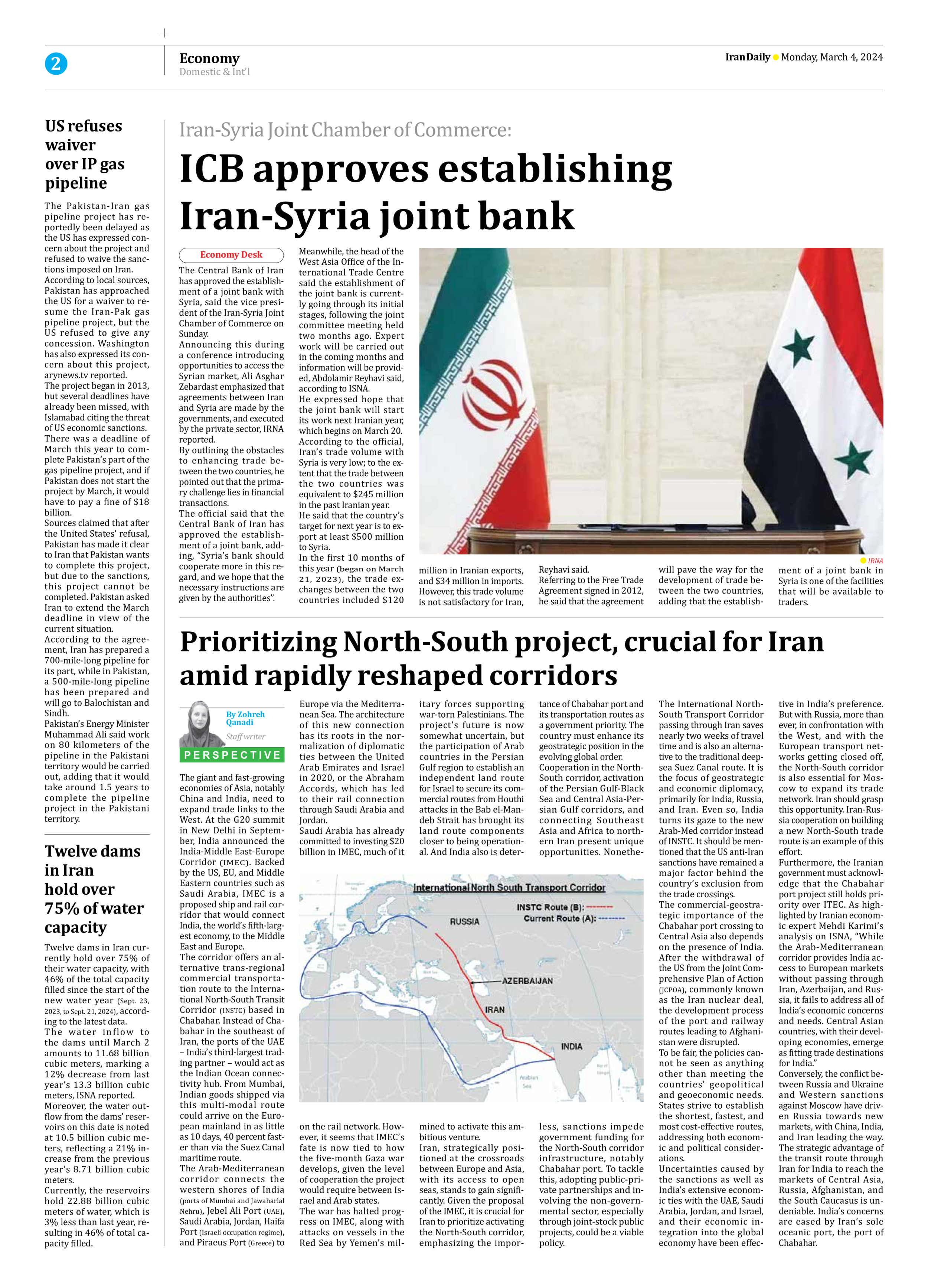
Prioritizing North-South project, crucial for Iran amid rapidly reshaped corridors
By Zohreh Qanadi
Staff writer
The giant and fast-growing economies of Asia, notably China and India, need to expand trade links to the West. At the G20 summit in New Delhi in September, India announced the India-Middle East-Europe Corridor (IMEC). Backed by the US, EU, and Middle Eastern countries such as Saudi Arabia, IMEC is a proposed ship and rail corridor that would connect India, the world’s fifth-largest economy, to the Middle East and Europe.
The corridor offers an alternative trans-regional commercial transportation route to the International North-South Transit Corridor (INSTC) based in Chabahar. Instead of Chabahar in the southeast of Iran, the ports of the UAE – India’s third-largest trading partner – would act as the Indian Ocean connectivity hub. From Mumbai, Indian goods shipped via this multi-modal route could arrive on the European mainland in as little as 10 days, 40 percent faster than via the Suez Canal maritime route.
The Arab-Mediterranean corridor connects the western shores of India (ports of Mumbai and Jawaharlal Nehru), Jebel Ali Port (UAE), Saudi Arabia, Jordan, Haifa Port (Israeli occupation regime), and Piraeus Port (Greece) to Europe via the Mediterranean Sea. The architecture of this new connection has its roots in the normalization of diplomatic ties between the United Arab Emirates and Israel in 2020, or the Abraham Accords, which has led to their rail connection through Saudi Arabia and Jordan.
Saudi Arabia has already committed to investing $20 billion in IMEC, much of it on the rail network. However, it seems that IMEC’s fate is now tied to how the five-month Gaza war develops, given the level of cooperation the project would require between Israel and Arab states.
The war has halted progress on IMEC, along with attacks on vessels in the Red Sea by Yemen’s military forces supporting war-torn Palestinians. The project’s future is now somewhat uncertain, but the participation of Arab countries in the Persian Gulf region to establish an independent land route for Israel to secure its commercial routes from Houthi attacks in the Bab el-Mandeb Strait has brought its land route components closer to being operational. And India also is determined to activate this ambitious venture.
Iran, strategically positioned at the crossroads between Europe and Asia, with its access to open seas, stands to gain significantly. Given the proposal of the IMEC, it is crucial for Iran to prioritize activating the North-South corridor, emphasizing the importance of Chabahar port and its transportation routes as a government priority. The country must enhance its geostrategic position in the evolving global order.
Cooperation in the North-South corridor, activation of the Persian Gulf-Black Sea and Central Asia-Persian Gulf corridors, and connecting Southeast Asia and Africa to northern Iran present unique opportunities. Nonetheless, sanctions impede government funding for the North-South corridor infrastructure, notably Chabahar port. To tackle this, adopting public-private partnerships and involving the non-governmental sector, especially through joint-stock public projects, could be a viable policy.
The International North-South Transport Corridor passing through Iran saves nearly two weeks of travel time and is also an alternative to the traditional deep-sea Suez Canal route. It is the focus of geostrategic and economic diplomacy, primarily for India, Russia, and Iran. Even so, India turns its gaze to the new Arab-Med corridor instead of INSTC. It should be mentioned that the US anti-Iran sanctions have remained a major factor behind the country’s exclusion from the trade crossings.
The commercial-geostrategic importance of the Chabahar port crossing to Central Asia also depends on the presence of India. After the withdrawal of the US from the Joint Comprehensive Plan of Action (JCPOA), commonly known as the Iran nuclear deal, the development process of the port and railway routes leading to Afghanistan were disrupted.
To be fair, the policies cannot be seen as anything other than meeting the countries’ geopolitical and geoeconomic needs. States strive to establish the shortest, fastest, and most cost-effective routes, addressing both economic and political considerations.
Uncertainties caused by the sanctions as well as India’s extensive economic ties with the UAE, Saudi Arabia, Jordan, and Israel, and their economic integration into the global economy have been effective in India’s preference. But with Russia, more than ever, in confrontation with the West, and with the European transport networks getting closed off, the North-South corridor is also essential for Moscow to expand its trade network. Iran should grasp this opportunity. Iran-Russia cooperation on building a new North-South trade route is an example of this effort.
Furthermore, the Iranian government must acknowledge that the Chabahar port project still holds priority over ITEC. As highlighted by Iranian economic expert Mehdi Karimi’s analysis on ISNA, “While the Arab-Mediterranean corridor provides India access to European markets without passing through Iran, Azerbaijan, and Russia, it fails to address all of India’s economic concerns and needs. Central Asian countries, with their developing economies, emerge as fitting trade destinations for India.”
Conversely, the conflict between Russia and Ukraine and Western sanctions against Moscow have driven Russia towards new markets, with China, India, and Iran leading the way. The strategic advantage of the transit route through Iran for India to reach the markets of Central Asia, Russia, Afghanistan, and the South Caucasus is undeniable. India’s concerns are eased by Iran’s sole oceanic port, the port of Chabahar.







